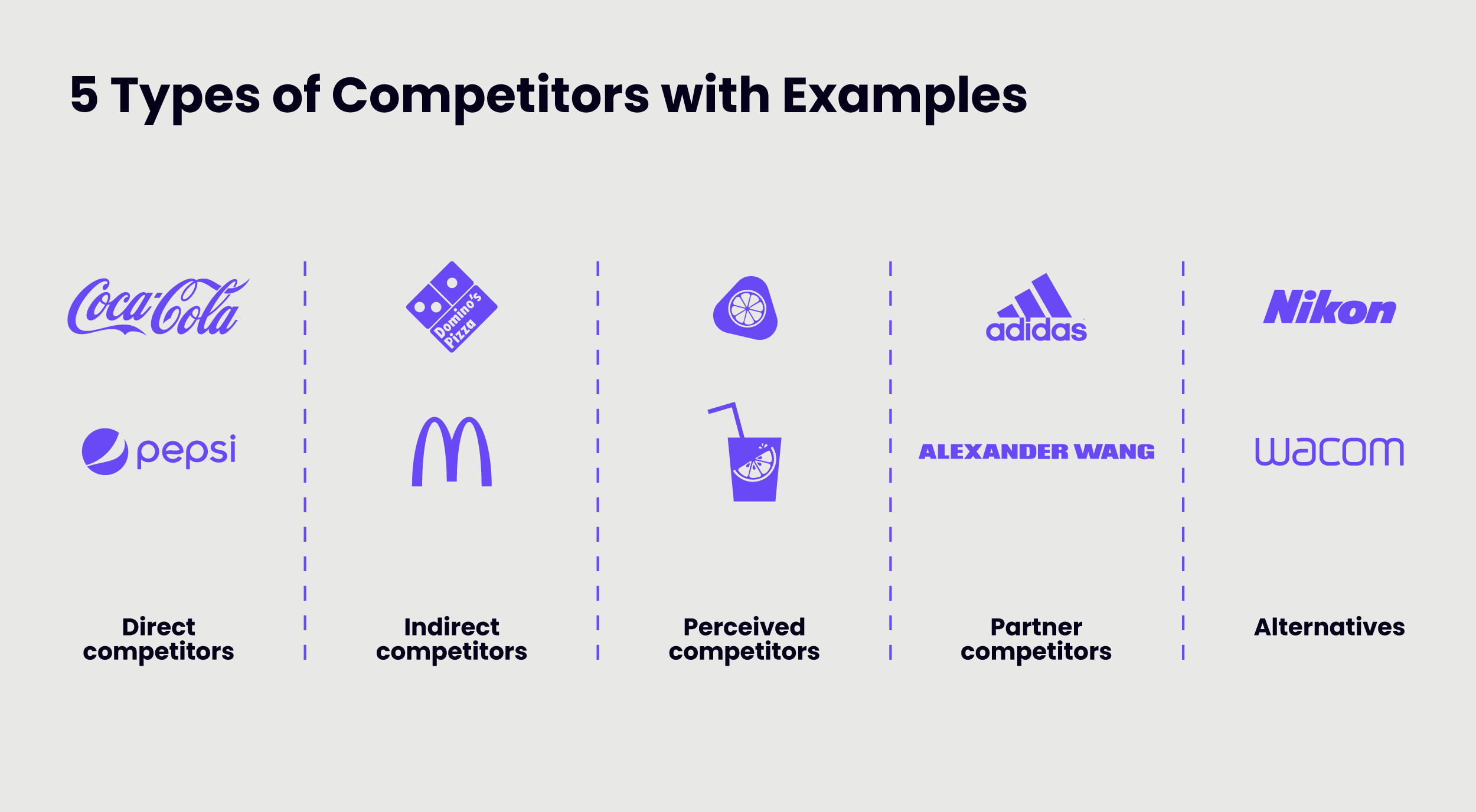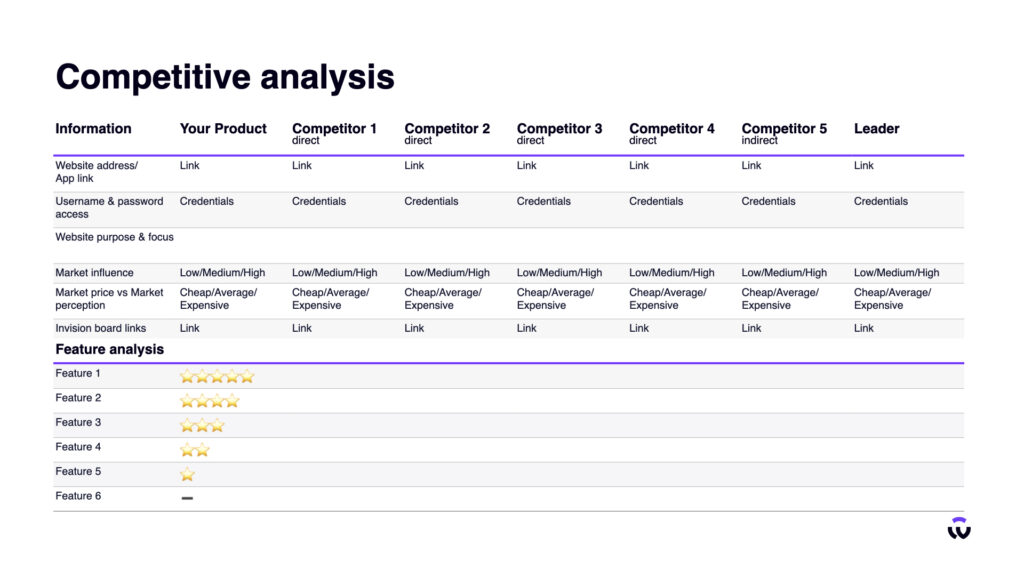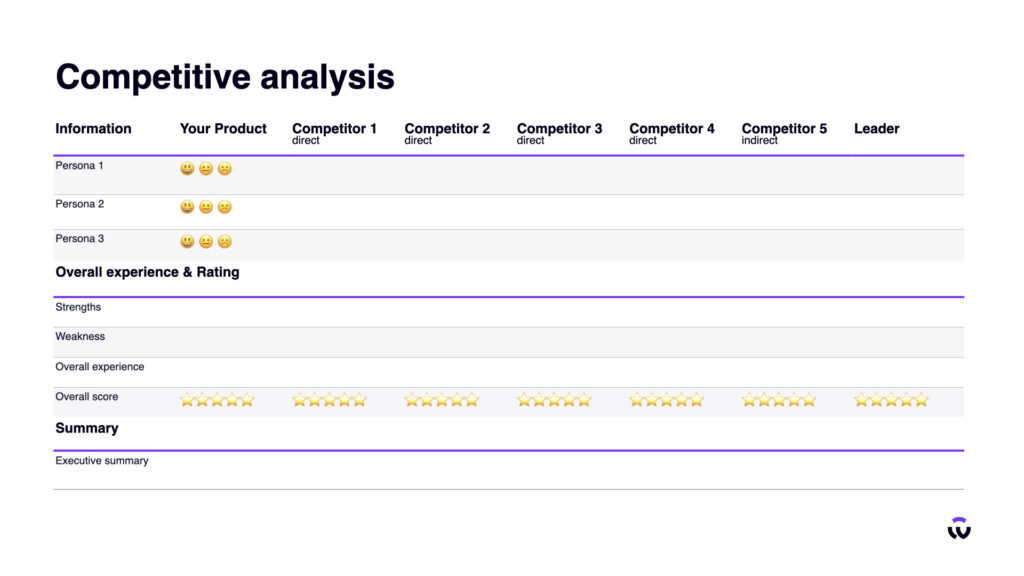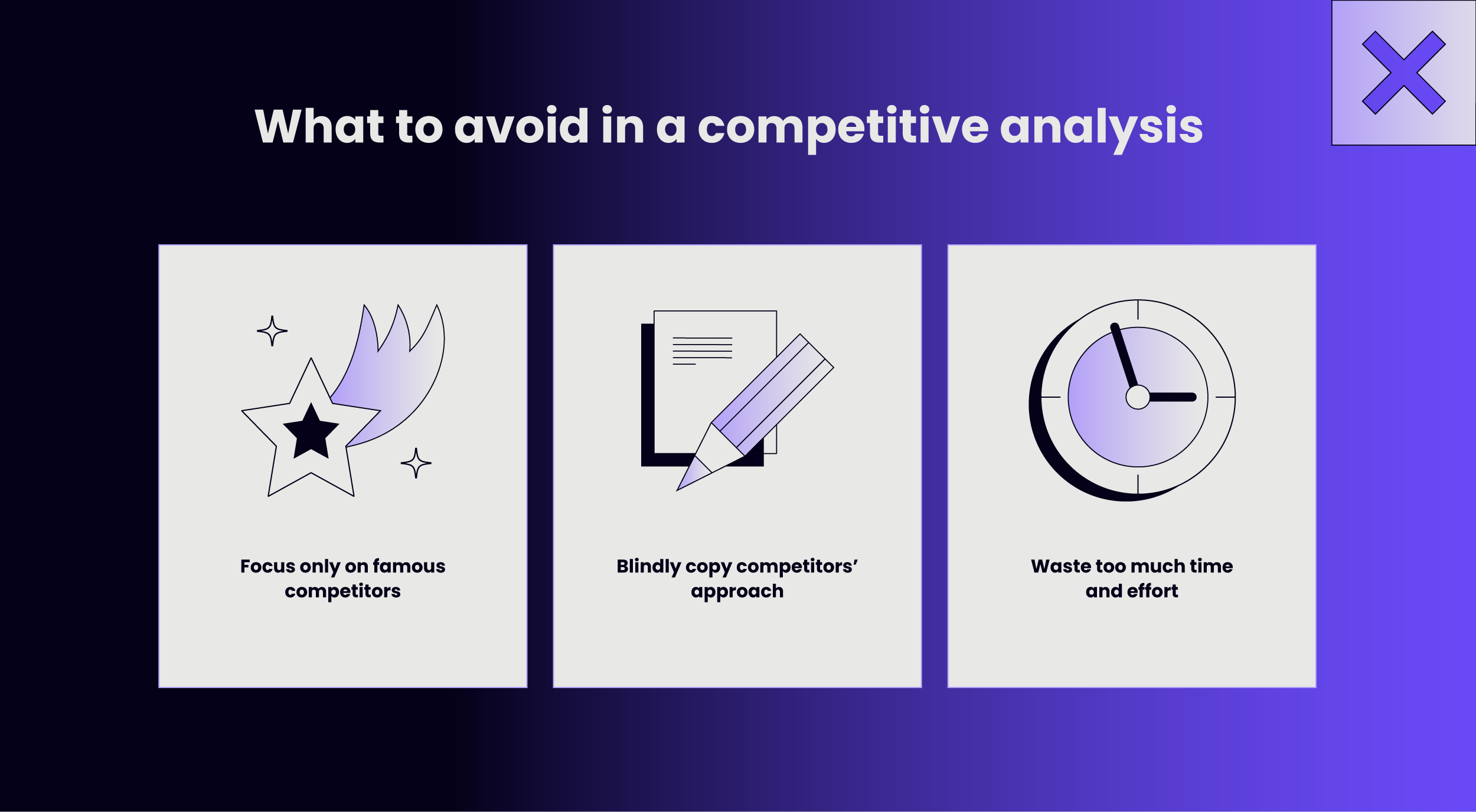Competitive Analysis: The Windmill Guide to Design Thinking
- UX & Design
Every company needs to stand out. Not necessarily in a showy, attention-grabbing way, a company must occupy a niche. There’s always a similar product or service available, making it important to know thy neighbor. What can your company offer that competitors don’t? What features make your product or service distinct from the rest? And more importantly, what can you learn from your competitors? Enter competitive analysis.
Ginni Rometty, the ex-CEO of IBM, states, “You’ve got to keep reinventing. You’ll have new competitors. You’ll have new customers all around you.”
A competitive analysis aims to assess competitors’ strengths and weaknesses and identify gaps in the market. This blog will serve as a guide to conducting a competitive analysis.
So without further ado, let’s dive right in.
Types of competitors
There are four main types of competitors you’ll encounter. They are:
Direct competitors: A direct competitor competes for the same users with the same problem and offers the same solution. The target audience and price points are also similar. A timeless example of two companies in direct competition is Coca-Cola and Pepsi, whose flagship products target the same audience (mass market) with the same problem (thirsty) and with the same solution (a sweet, cold drink at a low price point).
Indirect competitors: Indirect competitors compete for the same users with the same problem but offer different solutions. These are companies that make products that are slightly different but have the same target audience regardless. They also satisfy similar customer needs. An example of indirect competitors is Domino’s and McDonald’s. While they both sell different products (pizzas and hamburgers), they target the same audience: hungry customers looking for a quick and affordable meal.
Partner competitors: Business partners who partner in one aspect of their business but compete in other business areas can be called partner competitors. An example of partner competitors can be Alexander Wang and Adidas. The two companies collaborated and created clothing items and footwear. However, they are still competitors in the grand scheme of things as both are apparel and footwear brands.
Rival companies might team up because it’s strategically advantageous (such as to fight a larger competitor) or because their clients demand a solution that forces an integration of their services.
Alternatives: Alternatives don’t compete for either the same users, problem, or solution. They offer customers choices when they make buying decisions. They offer them utility and thus create competition between two companies. If a product serves a similar purpose as your product, it can be considered its alternative.
An example of alternate products is Nikon, the camera company, and Wacom Intuos, which makes creative pen tablets. If the price of Nikon products increase (due to a rise in e.g., input costs), the demand for alternatives, such as the tablets made by Wacom Intuos, may increase as a result.

Now we turn our attention to the methods and techniques involved in conducting a competitive analysis.
Why should a company do a competitive analysis workshop?
A competitive analysis provides direction on a large number of product-related concerns. These include:
- It provides an understanding of how your current and prospective customers perceive the competition.
- It provides you with a constructive assessment of your competitor’s strengths and weaknesses.
- It helps you discover what your competitors are up to and what kind of threat they pose to your company’s success.
- Understanding your competitors’ landscape not only informs your design decisions but also your overall product strategy.
- It reveals valuable opportunities for creating a superior product and distinguishing yourself from the competition.
- It aids in identifying industry trends and making more informed marketing decisions.
- It works in conjunction with a value proposition canvas to solidify a distinct value proposition.
- It aids the pricing of products and services.
- Discover new ways to reach customers, as well as new customer segments.
When should a company do a competitive analysis
Competitive analysis should be carried out:
At the beginning of a project
One of the first research steps in the UX design process is to conduct a competitive analysis. Before beginning work on a new project, conduct a UX competitive analysis.
Frequentative process
Because competitors can appear at any time and may increase (or improve) their offerings, the competitive analysis should be iterative and ongoing for the duration of the project.


Competitive analysis: a step-by-step process
If you have already downloaded the competitive analysis above, it’s time to learn how to make your product stand out among other market players.
Define objectives and prepare data gathering
Start by looking into your company. What areas and segments of the market do you cover? What sectors? What are your target keywords?
Then search for companies that are similar to yours. A good competitive analysis will likely return a list of global, national, and local competitors who are your direct or indirect competitors.
Any business marketing a product similar to, or an alternative for your product in the same geographic area is a direct competitor. Companies offering distinct or substitute products to your product or service are considered indirect competitors.
Secondly, before you conduct your research you need to have a well-organized place to store your gathered data. Whether digital records or paper.
Identify Competitors
Before you can assess and analyze your competitors, you have to know who they are. If you’re starting from scratch, Google is your friend. Search for…
- Terms that describe your business in a simple way, with an optional geographic modifier;
- Your SEO keywords (these might differ from your previous search if your marketing team has decided to avoid the most competitive keywords); and
- List-type articles that provide an overview of your industry.
For once, you can also pay attention to the top advert results. The ads will be from companies targeting the same areas as you.
Your second stop will be company reference websites such as Crunchbase and Owler, which allow varying levels of free access. Their information will be more reliable for larger companies, so pick a prominent competitor from your initial research and look through that company’s competitor list. From there, you can explore competitors in a branching fashion.
More fully featured sales and marketing solutions such as D&B Hoovers and Cognism may have higher data quality, but cost more. They’ll help you gather data about things like product suites, geographic locations, financial data, mergers and acquisitions activity, etc.
A free trial of one of these services can be a good option if you’ll only be working on your competitive research for a limited period. Sign up, gorge on the data you need, and cancel.
Collect information
Now it’s time to collect competitor data.
General company data
Target the quick wins first. Use the aforementioned company reference websites (Crunchbase, Zoominfo, Owler) to populate high-level competitor information such as financial data, owned geographies, products, M&A activity, and, if you’re lucky, marketing and strategy information.
For small or private companies, data quality will likely be poor compared to public companies, which are duty bound to provide company data so investors can make informed decisions. Finding information on such companies can be more of a manual process. The “About Us” section of a website is a good place to start, try also a Google News search for the company in question.
Search tip: Dun & Bradstreet has arguably the best company data, some of which is available for free. To access a limited version of Dun & Bradstreet’s paid-for data for free, we can leverage Google. Search for “[Company name] site:hoovers.com”. You may have to click around a bit to find the “ultimate parent” company of the organization you’re researching, which is likely the most useful one to find.
Internet performance and technology
You may want to include an analysis of a competitor’s website and internet presence. Tools exist to help with this and include SimilarWeb, Alexa Rankings, Buzzsumo, and Spyfu. These tools will help determine how competitors’ websites are performing and make it easier to track their growth.
You can also identify the web technologies that a particular site uses, should that be an important part of your sales strategy. These include SimilarTech, Builtwith, and What Runs.
Product Information
Obtaining product information is a bit more of a manual process. Use competitor websites to find out about their product offerings. Additional sources of product-related information includes data from websites such as G2Crowd, GetApp, and TrustRadius, which contain product reviews, providing customer insight. For companies active in the digital space, Google Play and Apple’s App Store are useful sources of information.
Collate your data
A visual board can be a helpful tool to evaluate competitors better. For marketing purposes, a visual board can be used for brainstorming, sprint planning, putting together customer and user journey maps, etc. Tools like InVision and Pinterest are popular for visual boards.
Here at Windmill, we use Miro. It’s an online whiteboard that allows for efficient team collaboration. The tool is also viable for documenting business meetings, managing workflows, etc.
Another way of categorizing competitors’ can be by using mind maps. XMind is an excellent tool for creating mind maps. Place your competitors (direct, indirect, partner) accordingly.

Using a Comparison Matrix
A comparison matrix is a tool used to analyze industry trends and helps compare different companies in the market. Not only does it aid in understanding their differences, but their strengths and weaknesses can be evaluated too. This data is beneficial for unveiling competitive advantage and potential growth opportunities. It will help leverage what makes your brand unique.
A comparison matrix can be created in many different ways. Here at Windmill, we use the Feature Comparison Matrix. This kind of comparison matrix includes several rows of features and columns of competitors, which helps compare the variety of products belonging to each competitor. The data for a Feature Comparison Matrix can be gathered via a competitive website analysis.
Experts also recommend using heat maps for data analysis. These maps help identify which parts of a business website are getting the most views by using a color spectrum. It helps to understand the behavior of visitors on a website.
What are the different comparison categories?
It’s essential for you to understand which comparison categories to include in your comparison matrix. Without the proper categories, a comparison matrix will fail to live up to its intended purpose.
When creating a comparison matrix, you must include:
Basic information: This section includes key attributes for identification. These include product names, short descriptions, supported platforms, website addresses, app links, etc. It also allows the user to save login and password information, giving them quick access to a competitor’s product.
Consider linking to a screenshot board as well. It will help you analyze each product feature’s visual aspects and specifications, thereby improving the quality of your competitive analysis.
Feature list: This section comprises all the features competitors’ products offer. Not only will it help determine the functionality of their products, but their quality too. Consider using color-coded scores as they can make it easier to assess quality levels.
Approximate sitemap: This category is all about defining and describing the organizational system. It includes the various product sections and patterns. Make sure the list provides a general overview of the structure, though it doesn’t necessarily need to be precise.
Heuristic evaluation: A heuristic evaluation will allow one to analyze the usability of a competitors’ products against a set of Heuristic Principles. Use the whole set of heuristics or pick a few of them, depending on the time available for research. However, it’s essential to evaluate the same heuristic for all competitors.
Feedback: Track the overall rating of competitors and then read their feedback to identify common threads. Reviews are valuable sources of information about a product, such as what people like or dislike, which features they would want the product to incorporate, etc.
Overall experience: State the strengths and weaknesses of your competitors here.
Business-specific: This section includes comparing the Pricing and Revenue Models of competitors to their overall performance. Such information can help you set the price of products. For example, consider comparing a company’s time on the market with its growth patterns. Knowing a company’s founding year can also help put its growth performance in perspective.
Comparing the target audience is also beneficial, as it helps to understand how the product appeals to current customers and whether there is a need to discover new ones.
Conclusion
To get the most out of one’s marketing efforts, a competitive analysis is essential. Luckily, there are so many different tools available today that one can use when conducting a competitive analysis. Whether it’s to assess competitors’ company profiles or to track their growth rates, these tools prove to be handy. Moreover, as there is an abundance of data to analyze, from identifying competitors to evaluating the various aspects of their companies, a comparison matrix can be helpful.
We’ve tried to make it as easy as possible for your team to benefit from the Competitive Analysis template. But nothing beats the guidance that an experienced design team can offer, so get in touch today to find out how Windmill can help your business clarify its value proposition, business model, and other key strategic pillars.


